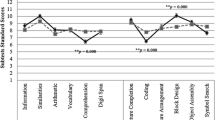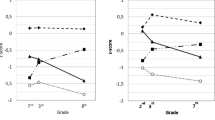Abstract
The relationship between cognitive deficits in high-level autism and those in learning disabilities has received little attention. To determine whether high-functioning autistic patients and individuals with severe dyslexia display different cognitive characteristics, 10 nonretarded men (mean age 26 years) with infantile autism, residual state, were compared with 15 severely dyslexic men (mean age 22 years) and 25 matched controls on a neuropsychological test battery. The two clinical groups were dissociated by a reduced digit span seen in the dyslexics and by impaired problem-solving skills (Wisconsin Card Sort and selected subtests from the Binet) seen in the autistic group. These results suggest different localization of brain dysfunction and different educational/habilitative needs.
Similar content being viewed by others
References
American Psychiatric Association. (1980). Diagnostic and statistical manual of mental disorders (3rd ed.). Washington, DC: Author.
August, G. J., Stewart, M. A., & Tsai, L. (1981). The incidence of cognitive disabilities in the siblings of autistic children.British Journal of Psychiatry, 138, 416–422.
Bartak, L., Rutter, M., & Cox, A. (1977). A comparative study of infantile autism and specific developmental receptive language disorder: III. Discriminant function analysis.Journal of Autism and Childhood Schizophrenia, 7, 383–396.
Bauman, M., & Kemper, T. L. (1985). Histoanatomic observations of the brain in early infantile autism.Neurology, 35, 866–874.
Damasio, A. R., & Maurer, R. G. (1978). A neurological model for childhood autism.Archives of Neurology, 35, 777–786.
Dixon, W. J. (1983).BMDP statistical software. Berkeley: University of California Press.
Finucci, J. M., Whitehouse, C. C., Isaacs, S. D., & Childs, B. (1984). Derivation and validation of a quantitative definition of specific reading disability for adults.Developmental Medicine and Child Neurology, 26, 143–153.
Folstein, S. E., & Rutter, M. L. (1988). Autism: Familial aggregation and genetic implications.Journal of Autism and Developmental Disorders, 18, 3–30.
Frith, U. (1970). Studies in pattern detection in normal and autistic children. II. Reproduction and production of color sequences.Journal of Experimental Child Psychology, 10, 120–135.
Frith, U., & Snowling, M. (1983). Reading for meaning and reading for sound in autistic and dyslexic children.British Journal of Developmental Psychology, 1, 329–342.
Galaburda, A. M., Sherman, G. F., Rosen, G. D., Aboitiz, F., & Geschwind, N. (1985). Developmental dyslexia: Four consecutive patients with cortical anomalies.Annals of Neurology, 18, 222–233.
Heaton, R. K. (1981).Wisconsin Card Sorting Test Manual. Odessa, FL: Psychological Assessment Resources.
Hermelin, B., & O'Connor, N. (1970).Psychological experiments with autistic children. Oxford, England: Pergamon.
Horwitz, B., Rumsey, J., Grady, C., & Rapoport, S. I. (1988). The cerebral metabolic landscape in autism: Intercorrelations of regional glucose utilization.Archives of Neurology, 45, 749–755.
Jastak, J. F., & Jastak, S. R. (1965).The Wide Range Achievement Test Manual. Wilmington, DE: Guidance Associates.
Lezak, M. (1983).Neuropsychological assessment (2nd ed.). New York: Oxford University Press.
Lincoln, A. J., Courchesne, E., Kilman, B. A., Elmasian, R., & Allen, M. (1988). A study of intellectual abilities in high-functioning people with autism.Journal of Autism and Developmental Disorders, 18, 505–524.
Lockyer, L., & Rutter, M. (1970). A five- to fifteen-year follow-up study of infantile psychosis: IV. Patterns of cognitive ability.British Journal of Social and Clinical Psychology, 9, 152–163.
Matthews, C. G., & Klove, H. (1964).Instruction manual for the adult neuropsychology test battery. Madison, University of Wisconsin Medical School.
Olson, R. K., Davidson, B. J., Kleigl, R., & Davies, S. E. (1984). Development of phonetic memory in disabled and normal readers.Journal of Experimental Child Psychology, 37, 187–206.
Osterrieth, P. A. (1944). Le test de copie d'une figure complexe.Archives de Psychologie, 30, 206–356.
Prior, M. R., & Chen, C. S. (1976). Short-term and serial memory in autistic, retarded, and normal children.Journal of Autism and Childhood Schizophrenia, 6, 121–131.
Reitan, R. M., & Davidson, L. A. (1974).Clinical neuropsychology: Current status and applications. New York: Wiley.
Rumsey, J., Berman, K., Denckla, M., Hamburger, S., Kruesi, M., & Weinberger, D. (1987). Regional cerebral blood flow in severe developmental dyslexia.Archives of Neurology, 44, 1144–1150.
Rumsey, J. M., Duara, R., Grady, C., Rapoport, J. L., Margolin, R. A., Rapoport, S. I., & Cutler, N. R. (1985). Brain metabolism in autism: Resting cerebral glucose utilization rates as measured with positron emission tomography.Archives of General Psychiatry, 41, 448–455.
Rumsey, J., & Hamburger, S. (1988). Neuropsychological findings in high-functioning men with infantile autism, residual state.Journal of Clinical and Experimental Neuropsychology, 10, 201–221.
Rumsey, J. M., Rapoport, J. L., & Sceery, W. R. (1985). Autistic children as adults: Psychiatric, social, and behavioral outcomes.Journal of the American Academy of Child Psychiatry, 24, 465–473.
Russell, E. W. (1975). A multiple scoring method for the assessment of complex memory functions.Journal of Consulting and Clinical Psychology, 43, 800–809.
Satz, P., & Morris, R. (1981). Learning disability subtypes: A review. In F. J. Pirozzola & M. C. Wittock (Eds.),Neuropsychological and cognitive processes in reading (pp. 109–141). Orland, FL: Academic Press.
Shea, V., & Mesibov, G. B. (1985). Brief report: The relationship of learning disabilities and higher-level autism.Journal of Autism and Developmental Disorders, 15, 425–435.
Spreen, O., & Benton, A. L. (1977).Neurosensory Center Comprehensive Examination for Aphasia. Victoria, BC: Neuropsychology Laboratory, Department of Psychology, University of Victoria.
Tallal, P., & Stark, R. E. (1982). Perceptual/motor profiles of reading impaired children with or without concomitant oral language deficits.Annals of Dyslexia, 32, 163–176.
Taylor, E. M. (1959). The appraisal of children with cerebral deficits. Cambridge, MA: Harvard University Press.
Terman, L. M., & Merrill, M. A. (1960).Stanford-Binet Intelligence Scale. Manual for the third revision, Form L–M. Boston: Houghton-Mifflin.
Wechsler, D. (1955).Wechsler Adult Intelligence Scale Manual. New York: Psychological Corp.
Wechsler, D. (1981).Wechsler Adult Intelligence Scale-Revised Manual. New York: Psychological Corp.
Author information
Authors and Affiliations
Additional information
The authors acknowledge that this research was supported in part by the Gulton Foundation, Tenafly, New Jersey. We also thank Jennifer Stepanek and Daniel Walsh for their assistance with data collection.
Rights and permissions
About this article
Cite this article
Rumsey, J.M., Hamburger, S.D. Neuropsychological divergence of high-level autism and severe dyslexia. J Autism Dev Disord 20, 155–168 (1990). https://doi.org/10.1007/BF02284715
Issue Date:
DOI: https://doi.org/10.1007/BF02284715




